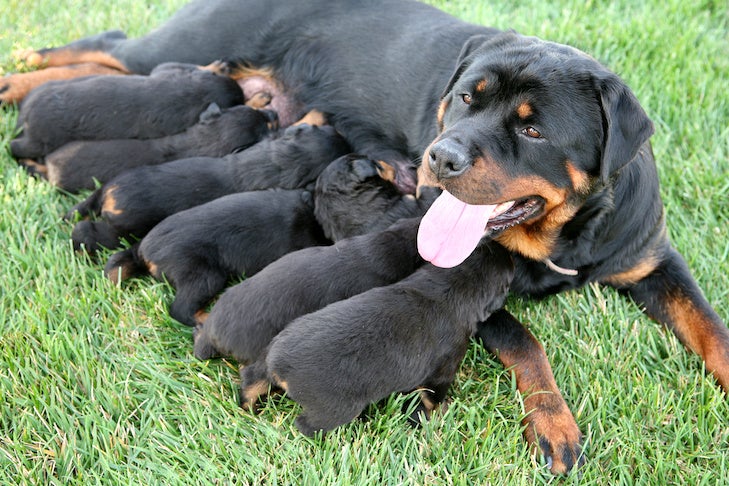For first-time breeders, the memories of whelping a litter and caring for puppies last a lifetime. Breeding a beloved bitch and raising healthy pups proves a rewarding but exhausting experience that novice breeders never forget. But despite the worry and work of preparing for your first litter, whelping the litter, then registering pups, these first-timers can’t wait to do it again. To learn more, we asked five newcomers what they would do differently when breeding their next litter of puppies.
Find a Mentor
Marcella Steele of St. Cloud, Minnesota, always wanted to breed a litter of Rottweiler puppies but didn’t know how to go about it. “I wanted to do it right, but I couldn’t find anyone in the Rottweiler world who was willing to mentor a newbie,” Steele says. “It felt like I was trekking through the forest wearing a blindfold. No one was saying, ‘Watch out for this or that.’ ”

When finding a mate for her female, Ava, Steele didn’t know Rottie pedigrees. She spoke with her breeder who suggested a related mating. Steele had whelped a litter of Shelties 10 years ago and felt familiar with that process.
“Luckily, my Obedience coach, an English Springer Spaniel breeder, agreed to help me,” Steele says. Ava gave birth to two puppies in June 2022 but needed an emergency Caesarean section to deliver the other five. “I love this breed so much, but next time I want to find a Rottweiler mentor.”
Ask the Breed Club
Dalmatian owner Sara Seitz of Phoenix, Arizona, also didn’t have a mentor but reached out to the Dalmatian Club of America for help with her female, Zoe. “Jessica MacMillan responded and explained how to read a pedigree, search the OFA database for health tests, and how to choose a stud dog,” Seitz says.
Three and a half years ago, Zoe went into labor at midnight, and Carol Hunter, a local Dalmatian breeder, drove an hour to assist with whelping. “I learned a lot,” Seitz says. For her recent second litter, Seitz focused on evaluating the strengths and weaknesses of a stud dog and prioritizing the pups’ quality. “To improve the breed, you have to be honest with what you have and where you want to go,” Seitz says.
Use Technology
Before Maria Swarts bred Sparkle, her female Finnish Lapphund, Swarts tapped in the wisdom of what she calls “the Collective”: a group of local Finnish Lapphund, Clumber Spaniel, and Canaan Dog breeders. Her learning curve also included reading books and watching webinars about breeding basics.
“Kendra Hutch bred a litter of Finnish Lapphunds two years ago, and she was great at explaining the health tests basics,” Swarts says. Hutch had connected with a breeder in Finland who shared her dog’s whelping on Zoom. “I wish I had seen a dog give birth before Sparkle’s big day,” Swarts says.
During COVID, Swarts interviewed potential puppy buyers via Zoom. “People lived around the country, so why not take advantage of the technology?” Swarts says. “I answered questions, gave people information about the breed, and showed Sparkle and the pups’ sire doing tricks and running around.”
What will Swarts switch up for the next litter? “I’ll plan due dates during the winter months, as the summers are too hot here in Tucson, Arizona,” she says. “I’ll put up better fencing to give the pups more room to run. I learned that Finnish Lapphunds do everything a day sooner than expected.”

Research, Research, Research
Attorney and first-time Canaan Dog breeder Jennie LaPrade believes that preparation is the key to laying the groundwork in all things. When choosing a purebred dog, LaPrade researched breeds. “I liked breeds in the Spitz family,” LaPrade remembers. “I wanted a healthy breed and an intelligent, independent dog similar to an Akita, but smaller.”
LaPrade zeroed in on Canaan Dogs, but finding a puppy from this rare breed proved challenging. “There are only five hundred Canaan Dogs in the U.S.,” she says. After an intensive search, LaPrade located Argos, a 4-month-old pup held back by the breeder for showing. Months later, after conducting more research, LaPrade found another breeder selling a female pup. “I wanted a good dog with health clearances to breed to Argos,” LaPrade says. “The Canaan Dog community is small, and I connected with breeders who helped me a lot.”
When the time came to breed Argos and Jessie, LaPrade relied on five Canaan breeders to answer questions. “I knew nothing, but they gave me a wealth of information,” LaPrade says. “Joan Greene, Argos’s breeder, came from Northern California to help me whelp the puppies and stayed a few days.” What would LaPrade do differently the next time she breeds? “I would buy better indoor and outdoor puppy pens and gates, but I wouldn’t change anything else.”
Know the Standard
Sam Starkey of Deer Park, Washington, loved Pembroke Welsh Corgis and wanted to breed a litter of healthy Pembrokes. After two years of searching for a well-bred puppy, Starkey bought Hope, a female puppy, from a non-show breeder.

“I didn’t know about a breed standard, and Hope is smaller than the standard,” Starkey says. “Papillon and Boxer friends gave me great advice about whelping, but the experience was nerve-wracking.” Hope naturally delivered three puppies but needed a Caesarean section when the fourth pup wouldn’t budge out of the birth canal.
“I registered the litter if the puppies need to return to me,” Starkey says. “I did a lot of socialization with the pups, but next time I will find a Pembroke breeder willing to work with me and a vet clinic closer than an hour away.”

